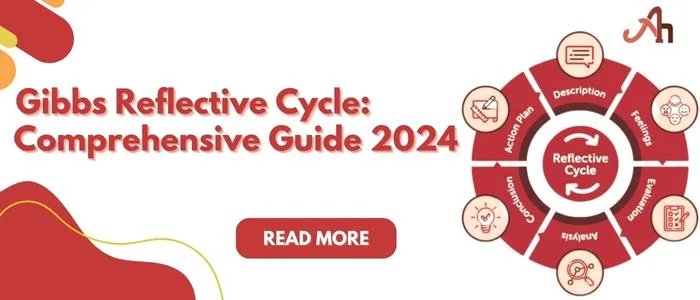


In the pursuit of academic excellence and personal development, students often find themselves grappling with the complexities of self-reflection. One invaluable tool that has emerged as a beacon in this journey is Gibbs Reflective Cycle. Whether referred to as the Gibbs Cycle of Reflection, the Reflective Cycle of Gibbs, the Reflective Cycle Gibbs, or simply the Gibbs Reflective Cycle, this framework has become synonymous with transformative learning experiences.
This blog post not only delves into the intricacies of the Gibbs Reflective Cycle but also serves as a bridge connecting it to the realm of academic success. We explore how this reflective model, often sought after for its profound impact, can be a guiding force in assignments, providing a structured approach to analyzing experiences and fostering deeper insights. Join us as we navigate the terrain of the reflective journey, discovering how the reflective cycle of Gibbs can be a powerful ally in not just personal growth but also in the realm of assignment success. Get ready for a holistic exploration, combining the realms of self-reflection and academic achievement.
The Gibbs Reflective Cycle serves as a model facilitating purposeful reflection. Reflection, in this context, involves a thoughtful exploration of experiences to gain new perspectives. Comprising six stages, the cycle guides you through describing experiences, as we delve into further sections of this blog.
Structured for intentional reflection on reviews, the Gibbs Reflective model prompts a considerate examination of personal experiences, feelings, and actions. The ultimate goal is to foster deep learning, self-awareness, and continuous personal improvement. The reflective writing model aims to cultivate a cycle of knowledge acquisition, self-discovery, and intentional growth through reflection.
Deeper Understanding: Systematically examining an event takes you beyond surface-level descriptions, allowing you to explore thoughts, feelings, and reactions. This introspection unveils hidden connections and nuances, enriching your comprehension of the situation.
Learning from Mistakes: The Gibbs model prevents mistakes from becoming dead ends. Each stage encourages analysis of what went well and what could be improved, extracting valuable lessons that pave the way for future success.
Boosting Confidence: Reflecting on achievements fosters a sense of accomplishment and builds confidence. Recognizing strengths and areas for development empowers you to tackle future challenges with a more assured stride.
Continuous Improvement: The cyclical nature of the model emphasizes the never-ending journey of self-improvement. Each experience becomes a stepping stone, propelling you towards personal and professional growth.
The Gibbs Reflective Model transcends mere academic exercise; it becomes a lifelong companion, equipping you with the tools to navigate life’s complexities. Whether you’re a student grappling with challenging coursework or a professional refining your skills, this framework empowers you to turn experiences into stepping stones, mistakes into valuable lessons, and challenges into opportunities for growth. Embrace the power of reflection, pick up your metaphorical compass, and embark on a journey of continuous learning and self-discovery. In the next section, we will discuss the 6 stages of the Gibbs Reflective Cycle with examples for easy comprehension. Let’s dive in!
Have you ever encountered a challenging situation in your studies, work, or even personal life, only to be left wondering how to learn from it and move forward? Well, fret no more, fellow UK learners! Enter the Gibbs Reflective Cycle, a potent tool that helps you dissect experiences, extract their essence, and emerge with valuable insights. Packed with six digestible stages, this framework is your ticket to unlocking continuous learning and growth. So, grab a cuppa, and let’s delve into the world of the Gibbs Cycle, complete with relatable UK examples!
Imagine yourself on a misty London morning, preparing for a presentation. This is the Description stage: paint a picture of the situation, the who, what, where, and when. Think of it as setting the stage for your reflective journey. What was the experience? Who were you involved with? What happened chronologically? Be as detailed as possible, like a true Agatha Christie crafting the scene of a crime!
Example: You’re a nursing student at St. Thomas’ Hospital in London, and you just finished observing a complex medical procedure. You were assisting the nurse but felt overwhelmed by the technical jargon and rapid pace.
Now, step into the emotional landscape of the experience. This is the Feelings stage, where you acknowledge your own internal weather. Were you nervous, excited, confused, or perhaps a mix of all three? Don’t shy away from the drizzle and sunshine of your emotions, for they hold valuable clues to your learning!
Example: Reflecting on the procedure, you felt a pang of anxiety mingling with a spark of curiosity. The technical terms were daunting, but you were also eager to learn and contribute.
It is time to assess the situation with a critical eye. This is the Evaluation stage, where you separate the “good biscuits” from the “crumbles” of the experience. What went well? What could have been improved? Be honest and objective, like a seasoned judge at the Great British Bake Off!
Example: You identify your thorough pre-reading as a positive, but realize relying solely on notes hindered your understanding during the live procedure. You also acknowledge your helpfulness to the nurse but wish you had spoken up about the confusing terminology.
Now comes the detective work! This is the Analysis stage, where you piece together the puzzle of your experience. Why did certain things happen the way they did? What underlying factors or theories might explain your feelings and the outcome? Think of it like navigating the intricate streets of London, searching for connections and patterns.
Example: You realize your reliance on notes stemmed from a fear of appearing unprepared, a common student anxiety. You connect the technical jargon gap to the lack of open communication with the nurse, potentially hindering your learning experience.
Time to reap the rewards of your reflective journey! This is the Conclusion stage, where you distill the wisdom gleaned from your analysis. What have you learned about yourself, your learning style, and the situation itself? Treat each insight like a precious diamond unearthed from a coal mine!
Example: You learn that relying solely on notes can limit your in-the-moment learning, highlighting the importance of active listening and asking questions. You also recognize the need for open communication in healthcare settings to bridge knowledge gaps and optimize learning experiences.
Finally, it’s time to put your newfound knowledge into action! This is the Action Plan stage, where you chart your course for the future. What will you do differently next time? How will you apply your learnings to future experiences? Think of it as plotting your next adventure on a London Underground map, with each stop representing a step towards continuous improvement!
Example: You decide to create flashcards with key terms for future procedures and practice active listening to clarify any doubts. You also plan to discuss your communication needs with the nurse educator to ensure a more collaborative learning environment.
For comprehensive assistance with the concepts and guidance, look no further than EssayCorp. Our expert team is ready to guide you through the nuances of this reflective model, ensuring a seamless understanding and application. Whether you’re a student seeking assignment help or a professional aiming for academic assistance, our services are tailored to meet your needs. Contact us today for support on your reflective journey with the Gibbs Reflective Cycle.
The Gibbs Reflective Cycle is a framework designed to facilitate purposeful reflection on experiences. It guides individuals through a structured process of describing, analyzing, and learning from their experiences, aiming to foster deep learning, self-awareness, and continuous personal improvement.
The Gibbs Reflective Cycle is a framework designed to facilitate purposeful reflection on experiences. It guides individuals through a structured process of describing, analyzing, and learning from their experiences, aiming to foster deep learning, self-awareness, and continuous personal improvement.
In the description stage, you detail the experience by answering the who, what, where, and when of the situation. This sets the foundation for reflection by providing a clear and detailed account of what happened.
Description: Setting the scene and detailing the experience.
Feelings: Exploring emotional responses to the experience.
Evaluation: Assessing what went well and what could be improved.
Analysis: Understanding why things happened as they did.
Conclusion: Drawing insights and lessons from the experience.
Action Plan: Planning how to apply the learning to future experiences.
The Feelings stage involves acknowledging and exploring your emotional responses to the experience. Understanding your emotions helps uncover deeper insights and can guide your reflective process.
The Evaluation stage involves critically assessing the experience to identify what went well and what could have been improved. This objective analysis helps highlight strengths and areas for development.